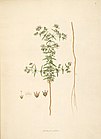Note: This is a project under development. The articles on this wiki are just being initiated and broadly incomplete. You can Help creating new pages.
Oldenlandia umbellata
Oldenlandia umbellata is a small, annual plant. The plant is gathered from the wild for local use as a medicine and dye. It used to be an important source of a red dye before the large-scale production of synthetic dyes started at the end of the 19th Century. It was commonly gathered from the wild and was also at one time often cultivated as a dye plant.
Uses
Parts Used
Chemical Composition
It contains eleven known compounds, hedyotiscone B (2), cedrelopsin (3), pheophorbide A methyl ester (4), deacetyl asperuloside (5), scandoside methyl ester (6), asperulosidic acid (7), scandoside (8), nicotinic acid (9), 6α-hydroxy geniposide (10) anthragallol 1,2-dimethyl ether (11) and anthragallol.[2]
Common names
| Language | Common name |
|---|---|
| Kannada | |
| Hindi | |
| Malayalam | |
| Tamil | |
| Telugu | |
| Marathi | |
| Gujarathi | |
| Punjabi | |
| Kashmiri | |
| Sanskrit | |
| English |
Properties
Reference: Dravya - Substance, Rasa - Taste, Guna - Qualities, Veerya - Potency, Vipaka - Post-digesion effect, Karma - Pharmacological activity, Prabhava - Therepeutics.
Dravya
Rasa
Guna
Veerya
Vipaka
Karma
Prabhava
Habit
Identification
Leaf
| Kind | Shape | Feature |
|---|---|---|
Flower
| Type | Size | Color and composition | Stamen | More information |
|---|---|---|---|---|
| {{{5}}} |
Fruit
| Type | Size | Mass | Appearance | Seeds | More information |
|---|---|---|---|---|---|
Other features
List of Ayurvedic medicine in which the herb is used
Where to get the saplings
Mode of Propagation
How to plant/cultivate
Prefers a well-drained, deep sandy soil.[4]
Commonly seen growing in areas
Photo Gallery
References
- ↑ Indian Medicinal Plants by C.P.Khare
- ↑ [Chemistry]
- ↑ [Morphology]
- ↑ Cultivation
External Links
- Ayurvedic Herbs known to be helpful to treat Bronchial catarrh
- Ayurvedic Herbs known to be helpful to treat Bronchitis
- Ayurvedic Herbs known to be helpful to treat Tuberculosis
- Ayurvedic Herbs known to be helpful to treat Asthma
- Ayurvedic Herbs known to be helpful to treat Poisonous bites
- Ayurvedic Herbs known to be helpful to treat Snake bites
- Herbs with Root bark used in medicine
- Herbs with stem used in medicine
- Herbs with leaves used in medicine
- Herbs with Root used in medicine
- Habit - Annual
- Index of Plants which can be propagated by Seeds
- Herbs that are commonly seen in the region of Prefers sandy soils along coasts
- Herbs that are commonly seen in the region of River banks
- Herbs


